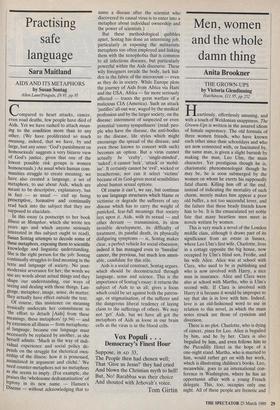Practising safe language
Sara Maitland
AIDS AND ITS METAPHORS by Susan Sontag
Allen Lane/Penguin, £9.95, pp.95
Compared to heart attacks, cancer, even road deaths, few people have died of Aids. Yet we have rushed to attach mean- ing to the condition more than to any other. (We have proliferated so much meaning, indeed, that we have, by and large, lost any sense: 'God's punishment on homosexuals' suggests a very bizarre view of God's justice, given that one of the lowest possible risk groups is women homosexuals.) As usual when human com- munities struggle to create meaning, we have also created a language, a set of metaphors, to use about Aids, which are meant to be descriptive, explanatory, but in fact — as usual — end up being prescriptive, formative and continually read back into the subject that they are supposed to elucidate.
In this essay (a postscript to her book Illness as Metaphor, which she wrote ten years ago and which anyone seriously interested in this subject ought to read), Susan Sontag attempts to decode some of these metaphors, exposing them to scientific knowledge and linguistic understanding. She is the right person for the job: Sontag continually struggles to find meaning in the texts and language of society. No post- modernist severance for her; the words we use are words about actual things and they shape our understanding, our ways of seeing and dealing with those things. Lan- guage, metaphor, image, sense, do matter; they actually have effect outside the text. . Of course, this insistence on meaning ironically undercuts her commitment to the effort to detach [Aids] from these meanings, these metaphors' (p.94) — and by extension all illness — from metaphoric- al language, because one language must necessarily be replaced by another, as she herself admits: 'Much in the way of indi- vidual experience and social policy de- pends on the struggle for rhetorical own- ership of the illness: how it is possessed, assimilated in argument and cliche.' We need counter-metaphors not no metaphors as she seems to imply. (For example, she praises the 'wholesome dedramatisation' of leprosy in its new name — Hansen's Disease — without acknowledging that to name a disease after the scientist who discovered its causal virus is to enter into a metaphor about individual ownership and the power of scientists.) But these methodological quibbles apart, Sontag has done an interesting job, particularly in exposing the militaristic metaphors too often employed and linking them with the xenophobia that is common to all infectious diseases, but particularly powerful within the Aids discourse. These wily foreigners invade the body, lurk hid- den in the fabric of the microcosm — even as they do in society. While Europe plots the journey of Aids from Africa via Haiti and the USA, Africa — far more seriously affected — traces the germ warfare of a malicious CIA (America). Such an attack 'justifies' all-out war, waged by the medical profession and by the larger society, on the disease: internment of suspected or even potential 'enemy sympathisers' (read: peo- ple who have the disease, the anti-bodies to the disease, life styles which might encourage the spread of the disease, and even those known to consort with such) becomes an option. But a virus cannot actually be 'crafty', 'single-minded', 'naked'; it cannot 'lurk', 'attack' or 'mobil- ise'. It certainly cannot be 'evil', wicked or treacherous; nor can it select 'victims' because of its God-given moral sensibilities about human sexual options.
Of course it can't, we say, but continue to use language structures which blame or victimise or degrade the sufferers of any disease which has to carry the weight of panicked, fear-full meanings that society lays upon it. Aids, with its sexual — and other deviant — transmission, its slow invisible development, its difficulty of treatment, its painful death, its physically disfiguring symptoms — is, Sontag makes clear, a perfect vehicle for social obsession; indeed it has managed even to tanalise' cancer, the previous, but much less amen- able, candidate for this role.
Aids is a social construct, Sontag argues, which should be deconstructed through language, sense and science. This is the importance of Sontag's essay: it returns the subject of Aids to us all; gives a focus which could be set against both the patron- age, or stigmatisation, of the sufferer and the dangerous liberal tendency of laying claim to the sufferings of others. We may not 'get' Aids, but we have all got the metaphors of Aids as loose in our brain cells as the virus is in the blood cells.


















































 Previous page
Previous page